The six key beaches of Mumbai have only 32 lifeguards, working in two separate shifts daily. The inadequate number of lifeguards is the result of the deplorable benefits and facilities offered to it
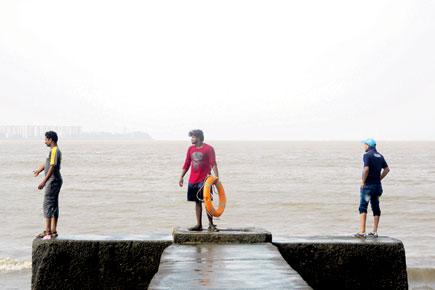
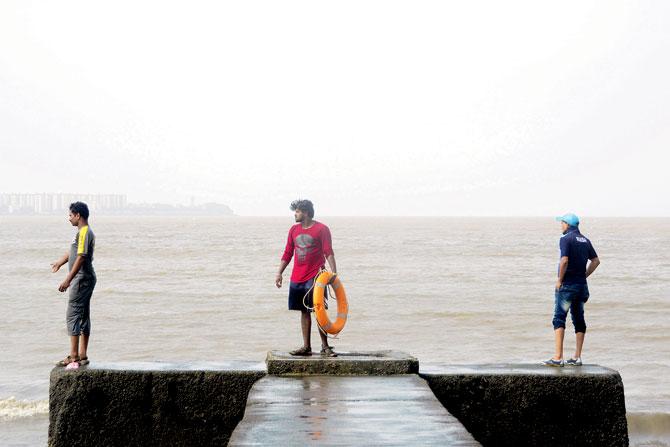
Girgaum Chowpatty has only three lifeguards for the 2-km stretch. Pic/ Bipin Kokate
ADVERTISEMENT
While Mumbai's filthy beaches are nothing to write home about. For many, they still continue to be a source of comfort from the unrelenting chaos of the megalopolis. But the city has shown little regard for the men who guard us against the vagaries of the ocean. The six key beaches of Mumbai have only 32 lifeguards, working in two separate shifts daily.
The inadequate number of lifeguards is not just the result of the authorities' lack of vision, but also the deplorable benefits and facilities offered to its staff.
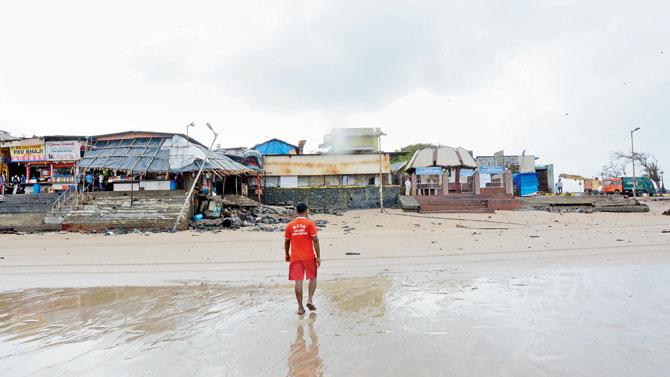 The only watchtower at Juhu Chowpatty collapsed during high tide early this week. Pic/ Satej Shinde
The only watchtower at Juhu Chowpatty collapsed during high tide early this week. Pic/ Satej Shinde
Mumbai has six major beaches that witness a footfall of over 1 lakh daily. On weekends and holidays, this number goes up to 10 lakh. But, the Mumbai fire brigade, which employs and trains these lifeguards, hasn't recruited anyone since 2012. The apathetic approach has left the city with just 32 staff to protect the city's beaches. As per international standards, there should be one lifeguard for every 300-m stretch.
Girgaum Chowpatty, one of the most important beaches in the city, has only three lifeguards manning the 2-km stretch. Of these, one is a permanent employee, while others work on contract basis. "We manage the duties among ourselves. But, manpower shortage results in poor beach surveillance," says a contractual lifeguard. "We mostly get help from the tourist police -- the special wing of the Mumbai Police to keep eye on tourist spots -- who make the rounds of the beach," he adds.
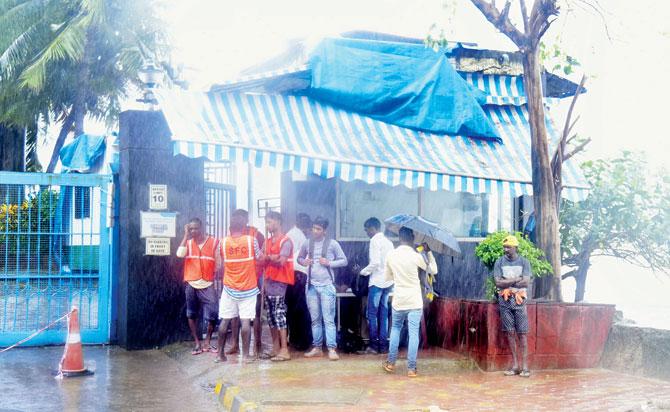 Dadar Chowpatty guards don’t have their own space and are forced to take shelter in shops during heavy rain. Pic/ Sameer Markande
Dadar Chowpatty guards don’t have their own space and are forced to take shelter in shops during heavy rain. Pic/ Sameer Markande
'No room to call our own'
The lack of infrastructure at these spots only makes matters worse. For instance, Girgaum Chowpatty has a one-storey wooden watchtower. "The beach is a low-lying area, which makes it difficult for us to keep a watch from the temporary watchtower, which is located further behind," says another lifeguard.
Further, with no binoculars or whistles, lifeguards are forced to stand near the shoreline to keep a close eye on the activities. "As per the norm, every lifeguard must have at least an identifiable place to sit, a uniform, a binocular, a whistle and a vehicle for surveillance. We've got nothing," says a lifeguard.
Dadar Chowpatty has its own set of problems. "The lifeguards at Girgaum have been given a place to monitor activities from. Here, we have nothing," says a Dadar lifeguard. This stretch has two permanent and five contractual guards working in shifts.
Since it's a narrow beach, during high tide, the water covers a major distance of the shore and the lifeguards are forced to stand in one of the bylanes near KirtiCollege, Chaityabhoomi or HindujaHospital. "Say, we are standing near KirtiCollege and someone is drowning at Chaityabhoomi, we either have to ride there on our bike or jump into the sea and swim there," a lifeguard explains.
Also, because there is no place from where they can operate, guards keep their rescue ring/tube at the nearbyShivajiParkfire station. "By then, a lot of time is lost."
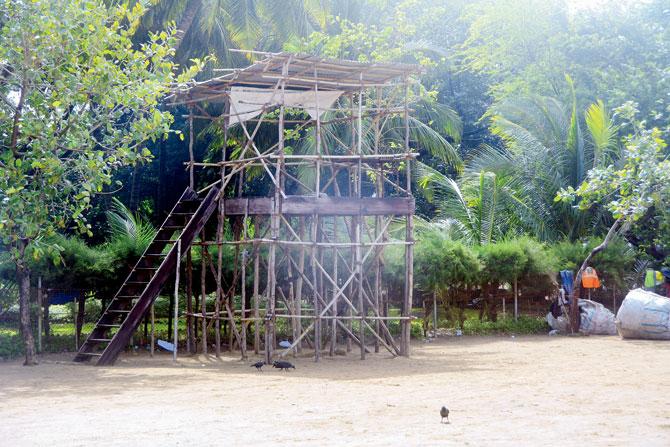
Girgaum Chowpatty only has three lifeguards manning the 2-km stretch. The guards only have a ramshackle one-storey wooden watchtower in the name of infrastructure. Pics/ Bipin Kokate
Nothing for contract staff
All contractual staff is hired on the basis of a run-swim-run test, in which they have to run for 200 km and swim the same distance. But, after getting recruited, no special training is provided. "We learn rescue techniques from the permanent staff or seniors at the beach," says a lifeguard.
Contractual lifeguards get a salary of Rs 12,000 with no medical benefits or leave. "If we are absent for even a day, they cut Rs 350-Rs 400. We don't have an identification card or uniform. So, when we take a rescued person to the hospital, we have to prove our identification, and in the process, we get embroiled in paperwork with the police," says a lifeguard at Juhu Chowpatty.
This 5.6-km-long beach, which has the maximum number of lifeguards, also lost its wooden watchtower during high tide on July 24. "Now, we are forced to sit wherever we find place. We keep our belongings at the nearby police chowky," he says.
 Subscribe today by clicking the link and stay updated with the latest news!" Click here!
Subscribe today by clicking the link and stay updated with the latest news!" Click here!






